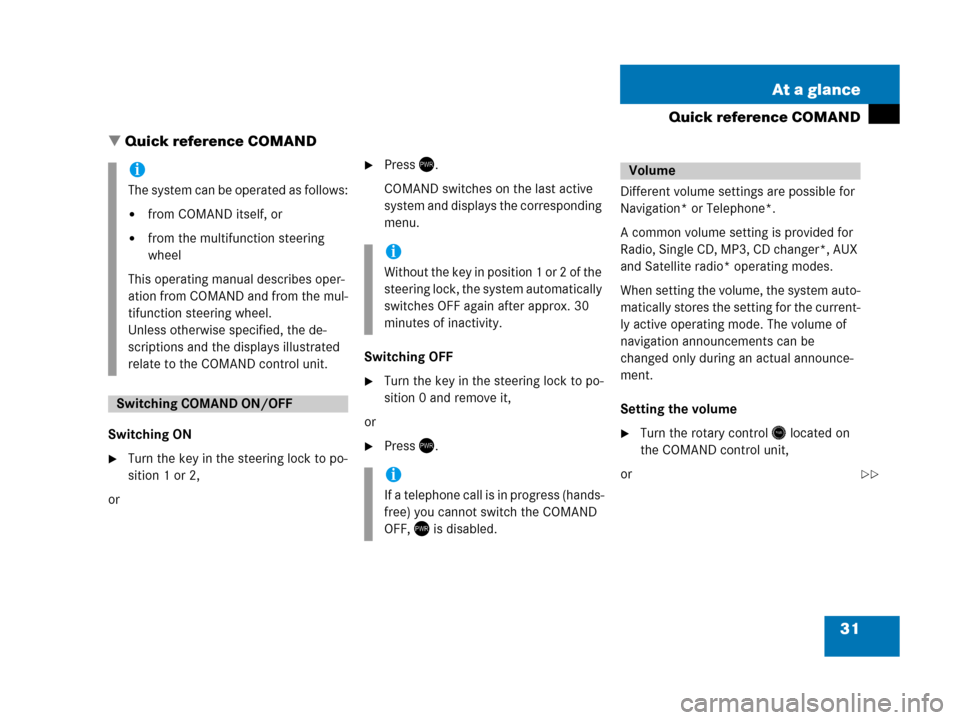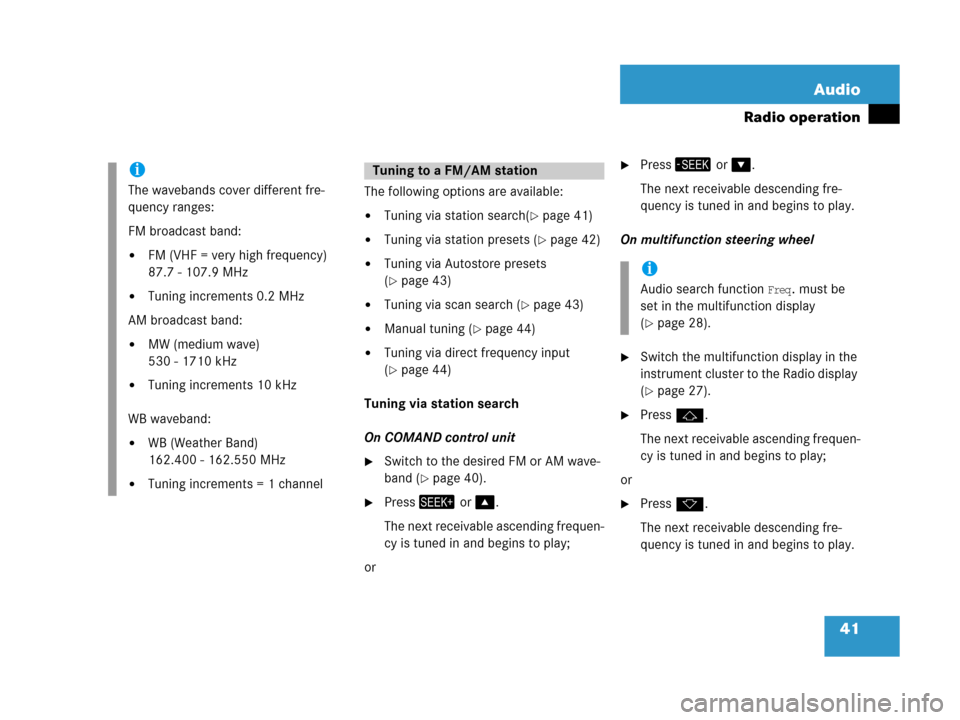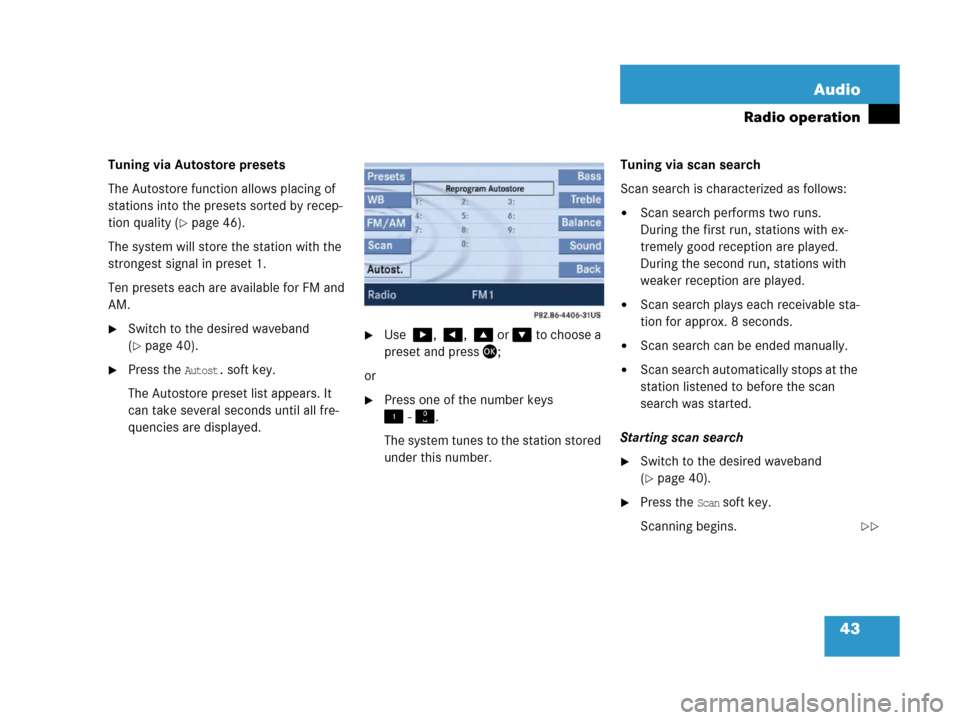Page 8 of 187

7
Where to find it
Introduction
� Where to find it
This Operator's Manual is designed to pro-
vide support for you, the COMAND opera-
tor. Each chapter has its own guide color to
provide fast access to information.
At a glance
Here you will find an overview of all
COMAND control elements and system
components. If you are operating
COMAND for the first time, or if you have
rented or borrowed the vehicle, this is the
chapter you should read first.
Audio
Here you will find all the information on
how to use the audio system and its radio
and CD components.
Satellite radio*
This chapter contains all information relat-
ed to the satellite radio system.
Telephone*
Here you can learn in detail about the
many functions of the telephone, SMS,
how to initiate an emergency call and use
service numbers.
Navigation*
This chapter provides detailed information
covering the following topics:
�Destination entry
�Route selection and calculation
�Route guidance
�Destination memory
Service
This chapter contains information con-
cerning Tele Aid*
System
This chapter provides information on how
to adjust COMAND system settings.
Directories
The glossary explains the most important
technical terms.
The table of contents and index directory
will help you quickly locate the information
you need.
Page 14 of 187
13 At a glance
Radio operating elements
FunctionPage
1 Audio main menu38
2 Soft keys
(multifunction buttons)
3 ! - "
Entering frequency man-
ually
Storing stations
Requesting station pre-
sets
44
46
42
FunctionPage
4 #, $, %, &
Tuning stations FM / AM
Station memory,
selecting presets
41
42, 46
5 '
Confirmation
6 (
Mute function
39
FunctionPage
7 )
Switching COMAND
ON/OFF
31
8 *
Volume adjustment
31
9 + and,
Station search
Manual tuning
42
44
Page 22 of 187
21 At a glance
Satellite Radio* operating elements
FunctionPage
1 SAT main menu80
2 Soft keys
(multifunction buttons)
3! - "
Entering channel manual-
ly
Storing stations
Requesting station pre-
sets
81
84
81
FunctionPage
4 #, $, %, &
Program category tuning
Station tuning
Station memory,
selecting presets
81
82
81, 84
5 '
Confirmation
6(
Mute function
39
FunctionPage
7 )
Switching COMAND
ON/OFF
31
8 *
Volume adjustment
31
9 + and,
Station tuning
82
Page 32 of 187

31 At a glance
Quick reference COMAND
� Quick reference COMAND
Switching ON
�Turn the key in the steering lock to po-
sition 1 or 2,
or
�Press).
COMAND switches on the last active
system and displays the corresponding
menu.
Switching OFF
�Turn the key in the steering lock to po-
sition 0 and remove it,
or
�Press).Different volume settings are possible for
Navigation* or Telephone*.
A common volume setting is provided for
Radio, Single CD, MP3, CD changer*, AUX
and Satellite radio* operating modes.
When setting the volume, the system auto-
matically stores the setting for the current-
ly active operating mode. The volume of
navigation announcements can be
changed only during an actual announce-
ment.
Setting the volume �Turn the rotary control* located on
the COMAND control unit,
or
i
The system can be operated as follows:
�from COMAND itself, or
�from the multifunction steering
wheel
This operating manual describes oper-
ation from COMAND and from the mul-
tifunction steering wheel.
Unless otherwise specified, the de-
scriptions and the displays illustrated
relate to the COMAND control unit.
Switching COMAND ON/OFF
i
Without the key in position 1 or 2 of the
steering lock, the system automatically
switches OFF again after approx. 30
minutes of inactivity.
i
If a telephone call is in progress (hands-
free) you cannot switch the COMAND
OFF, ) is disabled.
Volume
��
Page 42 of 187

41 Audio
Radio operation
The following options are available:
�Tuning via station search(�page 41)
�Tuning via station presets (�page 42)
�Tuning via Autostore presets
(
�page 43)
�Tuning via scan search (�page 43)
�Manual tuning (�page 44)
�Tuning via direct frequency input
(
�page 44)
Tuning via station search
On COMAND control unit
�Switch to the desired FM or AM wave-
band (
�page 40).
�Press+ or %.
The next receivable ascending frequen-
cy is tuned in and begins to play;
or
�Press, or &.
The next receivable descending fre-
quency is tuned in and begins to play.
On multifunction steering wheel
�Switch the multifunction display in the
instrument cluster to the Radio display
(
�page 27).
�Pressj.
The next receivable ascending frequen-
cy is tuned in and begins to play;
or
�Pressk.
The next receivable descending fre-
quency is tuned in and begins to play.
i
The wavebands cover different fre-
quency ranges:
FM broadcast band:
�FM (VHF = very high frequency)
87.7 - 107.9 MHz
�Tuning increments 0.2 MHz
AM broadcast band:
�MW (medium wave)
530 - 1710 kHz
�Tuning increments 10 kHz
WB waveband:
�WB (Weather Band)
162.400 - 162.550 MHz
�Tuning increments = 1 channel
Tuning to a FM/AM station
i
Audio search function Freq. must be
set in the multifunction display
(
�page 28).
Page 44 of 187

43 Audio
Radio operation
Tuning via Autostore presets
The Autostore function allows placing of
stations into the presets sorted by recep-
tion quality (
�page 46).
The system will store the station with the
strongest signal in preset 1.
Ten presets each are available for FM and
AM.
�Switch to the desired waveband
(
�page 40).
�Press the Autost. soft key.
The Autostore preset list appears. It
can take several seconds until all fre-
quencies are displayed.
�Use $, #, % or & to choose a
preset and press';
or
�Press one of the number keys
! - ".
The system tunes to the station stored
under this number.Tuning via scan search
Scan search is characterized as follows:
�Scan search performs two runs.
During the first run, stations with ex-
tremely good reception are played.
During the second run, stations with
weaker reception are played.
�Scan search plays each receivable sta-
tion for approx. 8 seconds.
�Scan search can be ended manually.
�Scan search automatically stops at the
station listened to before the scan
search was started.
Starting scan search
�Switch to the desired waveband
(
�page 40).
�Press the Scan soft key.
Scanning begins.
��
Page 47 of 187

46 Audio
Radio operation
Ten presets each are available for the
FM and AM waveband.
The following options are available:
�Storing manually using number keys
�Storing manually using the Presets
menu
�Storing using Autostore (�page 46)
Storing manually using the number
keys ! - "
�Tune to the station to be stored
(
�page 41).
�Press a number key between! and
" and hold it for more than 2 sec-
onds.
The station is now stored in the respec-
tive memory location.Storing manually using the Presets
menu
�Tune to the station to be stored
(
�page 41).
�Press the Presets soft key.
The Presets menu appears.
�Use$, #, % or & to select a
preset.
�Press' for more than 2 seconds.
The station will be stored in the respec-
tive memory location.Storing using Autostore
The Autostore function places stations into
the Autostore memory sorted by reception
quality.
The system stores the station with the
strongest signal in preset 1.
�Switch to the desired waveband
(
�page 40).
�Press the Autost. soft key.
The Autostore preset list appears.
Storing FM/AM stations
i
The Autostore feature stores presets in
a separate memory, not in the regular
presets seen under the
Presets soft
key. As such, the Autostore memory is
only temporary.
Page 81 of 187

80 Satellite radio*
Satellite radio operation
Station information is displayed on the
main area and in the center of the status
bar.
Main area, in this example:
�ROCK = selected category (�page 81)
�Vault = name of the selected station
Status bar, in this example:
�SAT (on the left) = the selected mode
�SAT5 = location in the program
memory, if the current channel is pre-
stored
�Ch16 = number of the current channel
Selectable soft keys
�Presets
shows channels pre-stored in the pro-
gram memory (up to 10 channels). You
can store stations (
�page 84) and re-
quest stored stations (
�page 80).
�Info
shows additional text information relat-
ed to the current channel.
�Scan
is used to start and stop the scan
search (
�page 83).
�Service
displays a screen showing the tele-
phone number of the Sirius Service
Center and electronic serial number
(ESN) of the receiver in your vehicle.
�You can also adjust the following:
�Balance (�page 32)
�Bass and treble (�page 33)
�Sound functions (�page 34)
�Volume (not on soft keys)
(
�page 31)
The following options are available:
�Tuning via station presets (�page 81)
�Tuning via manual channel input
(
�page 81)
�Tuning via the program category list
(
�page 81)
�Tuning a station within the selected
category (
�page 82)
�Tuning via scan search (�page 83)
SAT main menu
Selecting a station